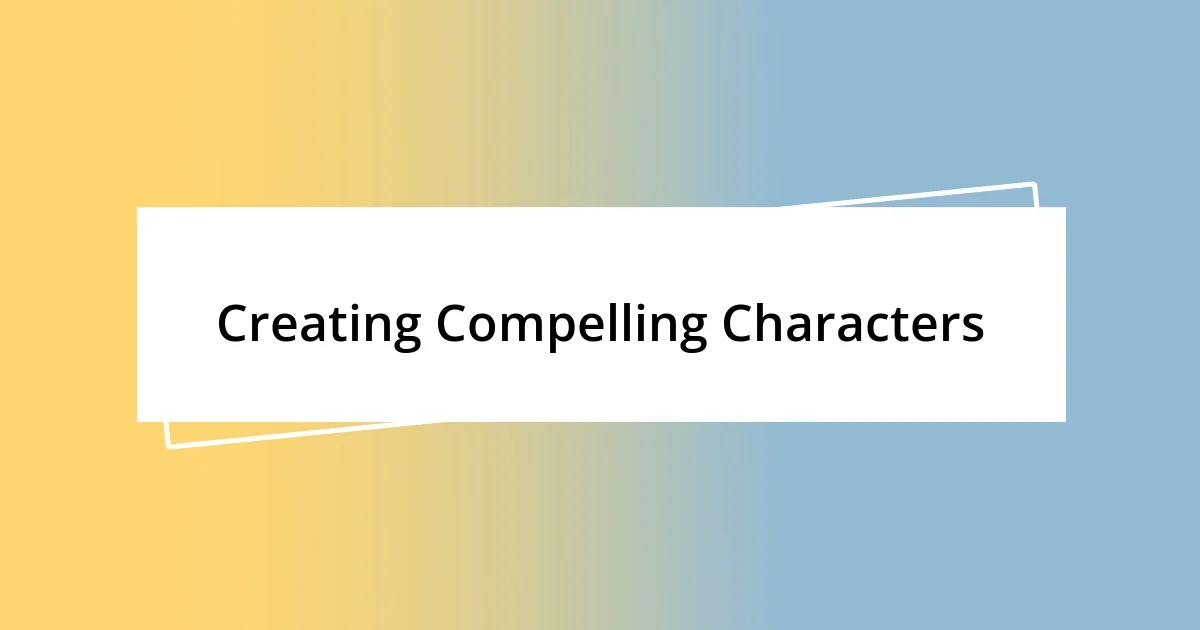Key takeaways:
- Emotional connection with readers is essential; relatable details and vulnerability in characters enhance storytelling impact.
- Understanding and incorporating themes and symbols enrich narratives and encourage personal reflection.
- The revision process and feedback from others play crucial roles in refining stories, revealing new insights and strengthening character development.

Understanding the Craft of Storytelling
Understanding the craft of storytelling goes beyond just stringing words together; it’s about connecting emotionally with your audience. I vividly remember the first time I made a reader cry with my story. It wasn’t through grand events or excessive drama but by tapping into simple, relatable emotions—reminding them of a moment they’d experienced themselves. Have you ever felt a rush of nostalgia while reading? That connection is the magic of storytelling.
Every great story has structure, but within that framework, there’s immense freedom. I often wrestle with where to place that pivotal moment or how to develop a character that feels real. One project taught me that even small details, like a character’s favorite mug, can paint a vivid picture and evoke memories in readers. Isn’t it fascinating how a simple object can become a vessel for deeper reflection?
As I dive deeper into my own storytelling journey, I’ve come to realize that vulnerability is essential. Sharing my struggles and fears through characters can make the narrative resonate on a personal level. I’ve found value in asking myself: “What truly matters in this story?” The answer often reveals layers I hadn’t recognized before, enriching the tale in ways I never imagined.

Identifying Themes and Concepts
Identifying themes and concepts is like finding hidden treasures within your narrative. When I started writing short stories, I often overlooked the underlying messages I wanted to convey. It wasn’t until I received feedback from a trusted mentor that I realized my tales often revolved around the theme of resilience. Recognizing this theme not only guided my writing but also enriched my characters, as they began to reflect this central idea in their development.
As I reflected on my stories, I also discovered how symbolism could reinforce my themes. For example, in one of my earlier works, a rainstorm represented the turmoil in my protagonist’s life. I remember feeling a sense of clarity when readers pointed out this metaphor. It made me realize that every element in a story should serve a purpose, tying back to the main concepts I aimed to explore. It’s like crafting a beautiful tapestry; each thread needs to align with the overall design.
When brainstorming new narratives, I always keep a list of themes that resonate with me—love, loss, or the struggle for identity. This habit stems from an experience when I felt stuck on a project. I turned to my personal experiences and picked a theme that mattered to me at that moment. That choice reignited my passion for the story and led me to develop a narrative that felt authentic and powerful. How do you approach themes in your own writing? Reflecting on your personal experiences can unlock deeper insights and meaningful connections with your audience.
| Aspect | Details |
|---|---|
| Themes | Core ideas that drive the narrative |
| Symbols | Objects or elements that reinforce themes |
| Personal Reflection | Utilizing personal experiences to shape stories |

Creating Compelling Characters
Creating characters that leap off the page often begins with understanding their core motivations. I remember crafting a character named Lily, who was always searching for her place in the world. As I developed her, I asked myself about her fears, dreams, and what kept her up at night. This exploration made me realize that when readers can empathize with a character’s struggles, they become invested in the journey.
To create more compelling characters, consider the following elements:
– Backstory: What past experiences shape them?
– Flaws: What imperfections make them relatable?
– Goals: What drives them forward? Are their goals achievable?
– Relationships: How do they interact with others?
– Change: What lessons will they learn throughout the story?
These factors intertwine to form a complex individual that readers can not only believe in but also root for. I once had readers tell me they saw parts of themselves in Lily, and it reinforced my belief that authenticity fosters connection.

Structuring Your Short Story
Structuring a short story is akin to building a sturdy house. I’ve found that a clear beginning, middle, and end serves as a solid framework. When I first attempted to write a story, I struggled to maintain that flow, often veering off track. However, once I embraced this structure, it not only helped my narrative but also kept my readers engaged from start to finish. Don’t you think a well-defined structure can enhance the reading experience?
Each story needs a hook in the beginning to lure readers in. I recall writing a piece where the opening line posed a question that resonated with the audience’s curiosity: “What if the last thing you saw was the face of your greatest fear?” This approach immediately drew them into the narrative. From there, I made sure to gradually build the tension in the middle, ultimately leading to a climax that left readers breathless. Can you remember a story where the beginning truly captivated you?
Lastly, I’ve learned the importance of a satisfying ending. I remember wrapping up one of my stories with an unexpected twist that tied everything together but also left readers reflecting long after they finished. Crafting an impactful conclusion is essential; it’s the last impression you leave, and it can resonate deeply with your readers. How do you typically choose to end your stories?

Engaging Readers with Emotion
Engaging readers with emotion requires tapping into the universal feelings we all share. I recall a time when I wrote about a character facing loss; it wasn’t just their grief I infused into the story, but also the myriad of sensations that accompany such an experience. As I dove deep into those emotions, I found that readers could not only relate but also vividly recall their own moments of heartache. Isn’t it fascinating how a character’s struggle can mirror our own?
To create that emotional connection, I focus on sensory details that evoke strong feelings. I remember describing a scene where my character was surrounded by fading photographs, the scent of old paper wafting through the air as they reminisced. As I wrote, I could almost feel the weight of nostalgia pressing down on me, and I hoped to convey that to my readers. Have you ever felt transported to a moment in a story simply because the details were so vivid?
Ultimately, I believe in the power of vulnerability. When characters reveal their inner fears or insecurities, it invites readers to do the same, allowing for a deeper connection. I once shared a story about overcoming a personal fear of inadequacy, and readers responded by sharing their own struggles in the comments. This exchange became a reminder that storytelling isn’t just about escapism—it’s a bridge, connecting hearts through shared experiences. How often do you see your own fears reflected in the stories you read?

The Revision Process Explained
The revision process is where the real magic happens in storytelling. After I finish a draft, I often let it sit for a few days—stepping away allows me to see my work with fresh eyes. When I finally dive back in, I’m usually surprised by what jumps out at me, whether it’s awkward dialogue or a lack of clarity in my themes. Have you ever noticed how taking a break reveals things you initially missed?
Digging deep into the details is crucial during revisions. I tend to focus on my characters’ motivations and the consistency of their arcs. For instance, there was a time I realized a character who began as hopeful ended up sounding jaded without a solid reason. I had to rewrite pivotal scenes to maintain that emotional journey for the reader. Isn’t it interesting how a single character shift can change the entire story’s tone?
In addition to character work, I pay attention to pacing. I once had a suspenseful scene that I inadvertently rushed through. After taking a step back, I decided to expand the moment by adding sensory descriptions, which slowed things down and built tension. This taught me that every moment in a story matters, and sometimes less really is more. What about you—do you find excitement in those slower, more deliberate moments within your own stories?

Sharing Your Stories for Feedback
Sharing your stories for feedback can be a transformative experience. I remember when I first dared to share my work with a writing group. The anticipation was nerve-wracking, yet their insights were invaluable. One member pointed out a character’s unrealistic reaction, which I hadn’t even noticed. Isn’t it amazing how a fresh perspective can illuminate aspects of our work we might overlook?
In my journey, I’ve learned that constructive criticism often comes dressed in kindness. Early on, I received feedback that felt harsh, but my mentor reminded me that it’s a crucial part of growth. After one humbling session, I rewrote a pivotal scene, resulting in more vibrant characters and a tighter plotline. Have you ever experienced that moment when feedback feels like a gentle nudge toward improvement?
Engaging with others about my stories has also sparked unexpected connections. During a workshop, I shared a story grounded in personal experiences. Not only did others relate to my themes, but they also opened up about their own journeys. Those conversations reminded me that storytelling is much more than an isolated act; it’s a dialogue between hearts and minds. Don’t you find that sharing your work nurtures a shared sense of understanding?














